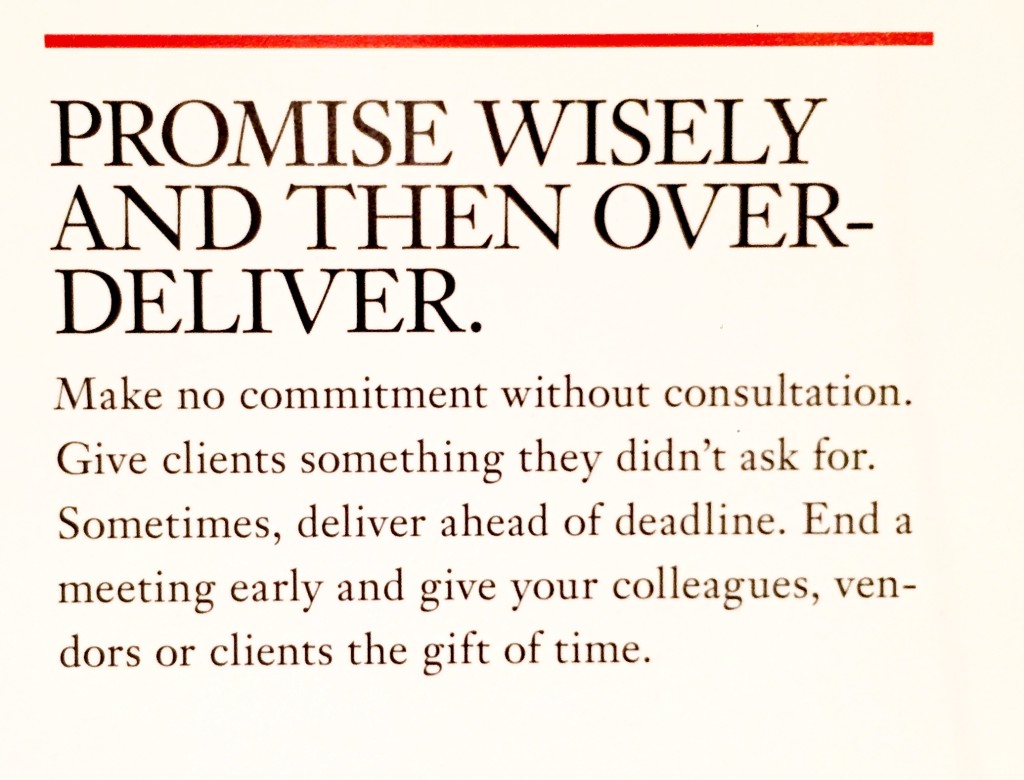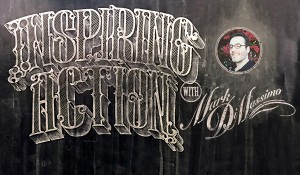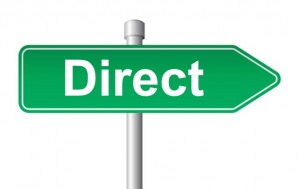By
Team DIGO | 05/13/2016 | in
Make no commitment without consultation. Give clients something they didn’t ask for. Sometimes, deliver ahead of deadline. End a meeting early and give your colleagues, vendors or clients the gift of time.

At DiMassimo Goldstein, we put our values in a document we call “The DIGO Standard.” It doesn’t just hang on the walls and sit on our desks and desktops. We use it every day. People who visit often ask for a copy. Here’s yours, and you didn’t even have to ask.
By
Team DIGO | 01/26/2016 | in
A few Fridays ago, our Chief Creative Officer, Tom Christmann, had the brilliant idea of testing whether or not our advertising skills would transfer over to lip-syncing.
Well, we’ll let you be the judge:
DiGo’s Greatest Hits from Ericagrau on Vimeo.
By
Team DIGO | 12/15/2015 | in
Inspiring Action
Key #8 of 10 to Inspiring Action: 10 Keys to the Future of Marketing. Download our summary poster of the 10 Keys here.
I led a brainstorm with a new client just the other day.
Their list of “growth blocks” was so like what other marketers have said, I thought I’d share them with you (and let you in on a powerful solution):
“We have the goods, but we don’t connect with the audience as well as we should,” admitted the COO, who had previously been the CMO.
“Seems like there are two kinds of creative people — those that understand the product and those that are great at talking to the audience. Unfortunately, we’re having a lot of trouble finding the overlap,” said the marketing director, still working through the grief of the recently ended agency relationship.
The internal creative director continued: “Most people don’t define creative excellence the way we do either. To us, it’s all about results first, and yes, being true to our brand. But that doesn’t seem to inspire or hold the attention of the best creative people. Plus, how do you literally put two messages into one communication. Isn’t that going to hurt results? I’m confused …”
Prioritize Creative Excellence.
What works better for growing a brand and business: great creative or powerful sales activation?
Here’s an intensive analysis of all 700 cases in the files of London’s respected Institute for Practitioners in Advertising (IPA), which found that companies with both outperformed those with either by a wide margin.
In fact, they found the two most important factors for success were advertising spend and creative excellence (as measured by, believe it or not, awards). Of those two most important factors, creative excellence even edged out size of budget as the most important factor.
In an increasingly crowded marketing landscape, great brands win. Great brands are built by great experiences, amplified by communications that move people powerfully. Smart marketing organizations are full of great strategists and brimming with great strategies ready to be tried. Most simply fail to be executed with great, on-strategy creative.
Connecting great marketing to winning creative isn’t easy, which is why it’s not normal either. Getting two very different tribes to work together to transcend the ordinary takes specific values and skills. Check out my Inspiring Action in Creative Teams: Seven Strategies for Prioritizing Creative Excellence.
-Mark DiMassimo, Chief
By
Team DIGO | 12/09/2015 | in

The Creative Director of the Dollar Shave Club is also the guy who made himself famous with a Google Experiment that got him a copywriter job in a top agency (budget $6). His name is Alec Brownstein, and he’s also the co-author of two best-selling comedy books, an award-winning copywriter, a film director and, yes, currently the creative director at the Dollar Shave Club. Spearheading one of the world’s fastest-growing and innovative companies, he’s quickly established himself as one of best outside-the-box thinkers in the industry.
Brownstein is also the mastermind behind the above mentioned “Google Experiment“, an inspiring example of how creative problem solving and persistence can put you in a position to succeed. The experiment gained him some overnight fame, but more importantly, it landed him a job. Listen in as Brownstein tells host Mark DiMassimo about how an unemployed International Relations graduate with zero marketing experience was able to catch the eyes of some of the industry’s most highly touted executives.
And, if you’re into laughing, you may want to order his books HERE and HERE. These books fit perfectly on a coffee table or even a bathroom, right next to your razor which you probably got from signing up to the Dollar Shave Club HERE.
By
Team DIGO | 11/30/2015 | in
Key #7 of 10 to Inspiring Action: 10 Keys to the Future of Marketing. Download our summary poster of the 10 Keys here.
One of the best things about doing my Inspiring Action Interviews has been the opportunity to have deep conversations with several of my most successful clients.
These are the CMOs that CEOs worship – marketers who have been highly successful again and again.
A common theme came up as we talked about the formative experiences we’d shared.

“Since that time I’ve been what you’d call a Brand Direct marketer.” – Ty Shay, CMO LifeLock
“That methodology has become the methodology I’ve applied ever since.” – Leslie Dukker Doty, CMO the Reader’s Digest Association
I first wrote about “brand direct” publicly almost twenty years ago. Since then the direct economy has taken over our lives, and just about every industry has been disrupted by it. This has mostly been a very good thing for me, as our clients over the past two decades have been doing more than their share of the disrupting.
Drowning in data, today’s marketers cry out for coherence. Even with programmatic trading desks, dashboards and optimizations, incremental improvements are only detectible to sophisticated machines.
Significant, meaningful, ongoing improvements in marketing efficiency are still possible, however. They simply require more than mere visual and verbal consistency.

The answer begins with a journey of discovery. The path of that journey is the customer journey itself. Together, we learn to see things from the customer’s point of view, from the prospect’s perspective. We uncover the insight – the inspiring idea – that will change and organize everything.
Then, together, we mine that inspiring idea to accelerate growth by up to ten times. Of course, this also dramatically alters the marketer’s journey!
Let’s alter your journey too!
-Mark DiMassimo, Chief
By
Team DIGO | 10/28/2015 | in
Recently there has been an influx of ad-block applications appearing on the App Store. These apps were developed in response to consumer backlash about the amount of advertising people were receiving when browsing on their smart phones, and have thus far been popular. As of last week, the three most downloaded apps on the App Store were ad-blockers.
As a consumer, I understand some of the frustrations with mobile ads; they are often intrusive into my expected experience, they often act more as pop ups and are not inline with my scroll, and they are sometimes difficult to close with my fat thumbs. Additionally, I have found some video ads particularly annoying, as they tend to eat up my data more quickly. With that said, I also realize they may be necessary for me to continue viewing “free” content.
As a marketer, I share some of the frustrations but think most of the instances are a result of other marketers not doing an effective job of picking and choosing the placements that seamlessly integrate into the user experience. High impact sounds good and all, but if it annoys the consumer then all you are doing is drawing negative connotation to the brand and the ad.
As a marketer and consumer, I know there must be a better way to advertise and incorporate that advertising in my expected user experience. Companies like Sled Mobile are working to solve the issue by developing and serving high impact ads that are in stream with a user’s scroll, but more can certainly be done and not just from the delivery side but also from the creative and placement side.
Planners need to be working harder to ensure that the ads they are placing are in an environment where the user is getting some good content. The user will then be more closely aware that the ad is the reason why the content is free ex: YouTube, but it needs to be something relevant to them individually. Broad and untargeted placements do not work on mobile; ads should be helpful and relevant.
From a creative standpoint, there should be more emphasis on unique and dynamic messaging. Messaged should be catered to location or user activity. The adaptation of a standard desktop display ad to mobile is no longer acceptable.
Being a consumer and marketer gives me a unique perspective; however the one perspective I am not afforded is that of the content provider. What will ad-blocking applications mean for them? Unfortunately, it could mean death. With ads being blocked, we must ask how the content provider is to stay in business. Everyone loves the idea of free content but unfortunately it’s just an idea and not a reality. Everything on the back end; writers, contributors, designers and webmasters must be paid for.
How is the content provider or publisher to stay in business if they cannot monetize on their offering and recoup some of the costs associated with content creation? Native or custom content is one option, but there certainly isn’t enough demand to fund a full content offering just yet. Would users visit a site if every piece of content on there was co-created by an advertiser? I think not.
Before we all go out and start downloading ad-blockers, we should first think about the possible repercussions on the content providers we know and love.
-Dan Sauvigné, Associate Media Director, Proove Accountable Media
By
Team DIGO | 10/26/2015 | in
 Starting a new job can be a very exciting time in your life, but the process often leaves you feeling uneasy and intimidated. You’re the new kid on the block, doing your best to navigate your new surroundings and make a good impression. Most of us will quickly try to find allies in the office, but that isn’t always easy to do. It doesn’t help that stressful situations, back-to-back meetings and timely deadlines are not the ideal ingredients for relationship building.
Starting a new job can be a very exciting time in your life, but the process often leaves you feeling uneasy and intimidated. You’re the new kid on the block, doing your best to navigate your new surroundings and make a good impression. Most of us will quickly try to find allies in the office, but that isn’t always easy to do. It doesn’t help that stressful situations, back-to-back meetings and timely deadlines are not the ideal ingredients for relationship building.
In September 2015, Fast Company published an article breaking down the importance of having friends in the work place and why it is crucial to our happiness. The article claims that even though we spend most of our days at work, we are less likely to have friends in the office now in comparison to past years. Although this seems like a problem most directly affecting employees, it is also a troublesome problem for employers looking to maintain a positive, productive work place where they can groom long-term talent.
Since our mission at DiMassimo Goldstein is to Inspire Action, we set out to find a solution to this growing problem in the hopes of increasing employee happiness, productivity and motivation. The solution was to start a two-month lunch program that gives employees the opportunity to go to lunch with one another. Each lunch you get thirty dollars to spend with your buddy and the only guideline is that it should be with someone you don’t know very well.
Being one of the newer employees at DiGo, I wanted to take advantage of this fantastic opportunity. My work life was very separate from my personal life when I first started in May, and although I loved my new role, I wasn’t as friendly with my coworkers as I had been at previous jobs. This new company program gave me the confidence and opportunity to reach out to coworkers in various departments including creative, strategy, operations, media and production. This also opened the door for me to reach out to senior staff members that I didn’t otherwise interact with on a regular basis.
There are so many reasons I have enjoyed this program, aside from my love of free food. After speaking with different people from different departments, I learned more about how each department functions on a day-to-day basis and ways the account team can better work with them. Having a reason to get out of the office and get some fresh air helped me focus better in the afternoon and increased my productivity level. I noticed I feel much more comfortable walking around the office, chatting with people before meetings or even bumping into them in the kitchen. Most importantly, I had the opportunity to ask advice from people with valuable experience which will not only help me grow at DiGo, but also as young person in the advertising industry.
When introducing this program to the company, Mark DiMassimo explained that the goal was for everyone to be able to say they have at least six friends in the office. After speaking with some of my new lunch buddies, I can confidently say that many of us have accomplished that goal and then some.
And they say there’s no such thing as a free lunch…
-Morgan Kelly, Brand Manager
SOURCE: http://www.fastcompany.com/3051290/lessons-learned/why-having-friends-at-work-is-so-important
By
Team DIGO | 10/08/2015 | in
Even if you’re not in love with your planet or passionate about conservation and even if you’re annoyed by organizations that change the world for the better, this edition of the “Inspiring Action Podcast” is for you. Paul Butler is the senior vice president of global programs for Rare, an innovative not-for-profit organization committed to inspiring change so that people and nature can thrive.
Over the course of forty-five riveting minutes, Butler tells host Mark DiMassimo how his lifetime passion became his profession when a 6-month voyage to St. Lucia evolved into a 12-year mission. That mission – to save a species – led to an adventure you’ve just got to hear!






 Starting a new job can be a very exciting time in your life, but the process often leaves you feeling uneasy and intimidated. You’re the new kid on the block, doing your best to navigate your new surroundings and make a good impression. Most of us will quickly try to find allies in the office, but that isn’t always easy to do. It doesn’t help that stressful situations, back-to-back meetings and timely deadlines are not the ideal ingredients for relationship building.
Starting a new job can be a very exciting time in your life, but the process often leaves you feeling uneasy and intimidated. You’re the new kid on the block, doing your best to navigate your new surroundings and make a good impression. Most of us will quickly try to find allies in the office, but that isn’t always easy to do. It doesn’t help that stressful situations, back-to-back meetings and timely deadlines are not the ideal ingredients for relationship building.